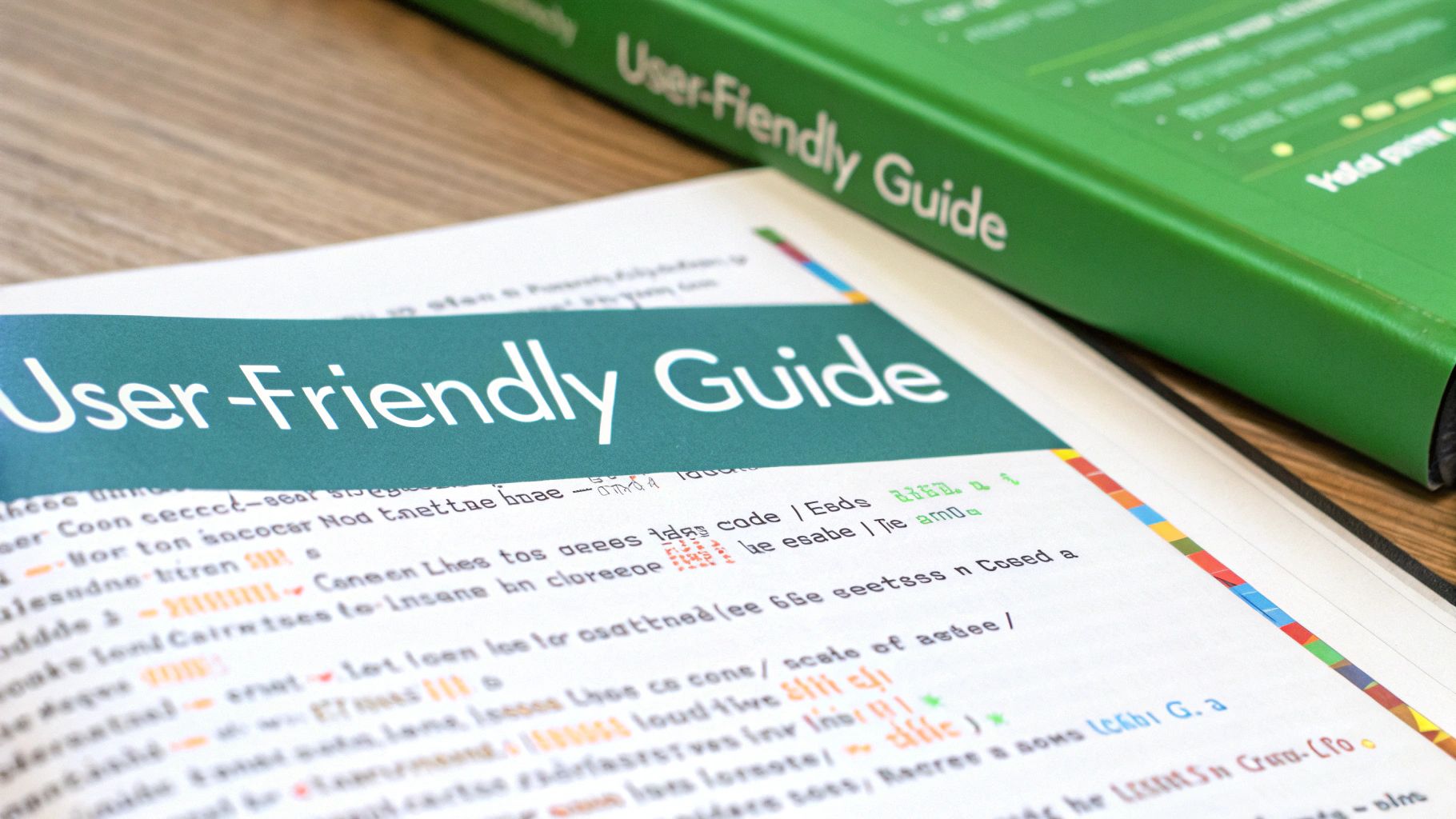Transforming Your Documentation Strategy

Poor software documentation has real costs for businesses and teams. Data entry errors alone cost companies over $600 billion each year. Knowledge workers spend half their work hours creating and preparing documents, yet 25% of these important resources get lost. This leads to countless hours wasted recreating missing materials - a problem that affects 83% of employees. Clearly, better documentation practices are essential.
Consider a large software project with hundreds of connected modules. Without clear, current documentation, developers waste hours trying to understand existing code, leading to mistakes and missed deadlines. This shows why documentation needs to be treated as a core part of development rather than an afterthought. Good documentation helps teams work faster, collaborate better, and build higher quality software.
Rethinking Documentation for Maximum Impact
Better documentation starts with seeing it as an ongoing process that grows with your software. This means using the right tools and methods to keep information accurate, accessible and useful.
Here are the key elements of better documentation:
- Put users first: Create documentation that meets the specific needs of developers, admins, and end users at their skill level
- Make it easy to find: Use clear organization, simple language, and helpful visuals so people can quickly find what they need
- Enable teamwork: Set up systems for multiple people to contribute and review documentation while tracking changes
- Pick proper tools: Use the tools that fit your needs - from basic markdown editors to full documentation platforms. Include code examples and interactive elements to help understanding
Practical Steps for Transformation
While changing documentation practices takes work, breaking it into clear steps makes it manageable:
- Review what you have: Look at your current documentation to find gaps and problems to fix
- Set clear targets: Make specific, measurable goals like reducing support requests by 20% through better user guides
- Create writing guidelines: Build a style guide covering formatting, tone and terminology to keep everything consistent
- Plan the process: Define clear steps for creating, reviewing and updating documentation as part of development
- Track and improve: Monitor key metrics to see what’s working and adjust your approach based on results Following these principles turns documentation from a burden into a valuable asset that reduces errors and speeds up development. Moving to digital documentation also helps the environment - considering that the US alone discards about 1 billion trees worth of paper annually. This reinforces why good documentation practices matter for both productivity and sustainability.
Building Documentation That Actually Gets Used
Every developer knows the frustration of dealing with poor documentation. But creating documentation that developers actually want to use goes beyond simply recording information - it requires understanding how developers work and what makes documentation genuinely helpful. Let’s explore how to build documentation that becomes an essential part of the development workflow rather than a neglected resource.
Designing for the Developer Experience
Think about how you use documentation in your own work. Like most developers, you probably don’t read it cover-to-cover - you search for specific answers when you hit a roadblock. Good documentation anticipates this behavior and makes finding solutions quick and painless. Here’s what that means in practice:
- Searchable: Strong search functionality with strategic keywords helps developers zero in on relevant information fast. When a developer needs to fix a specific error, they should be able to find the solution in seconds.
- Concise: Skip the fluff and focus on clear, direct explanations. Rather than long theoretical discussions, provide practical code examples that developers can implement right away.
- Actionable: Give developers concrete steps they can follow. For instance, when documenting an API, include ready-to-use code snippets showing how to make calls, handle responses, and fix common issues - not just abstract descriptions of what the API does.
Structuring for Success: Example Hierarchies
Good structure makes documentation intuitive to navigate. Different types of documentation need different approaches:
- Tutorial Style: Perfect for walking new users through complex processes step-by-step, with clear examples and explanations along the way.
- Reference Style: Functions like a technical dictionary - brief, focused entries that make it easy to look up specific details about functions, classes, or API endpoints.
- FAQ Style: Answers common questions and troubleshooting needs directly, making it quick to resolve frequent issues.
Maintaining Living Documentation
Documentation needs regular updates to stay useful. As your code evolves, your documentation should keep pace. Here’s how to make that happen:
- Version Control: Track documentation changes alongside code changes using systems like Git. This keeps everything in sync and makes it easy to see what’s changed.
- Automated Builds: Make documentation updates part of your build pipeline so new code changes automatically trigger documentation updates.
- Community Contributions: Welcome input from your user community through pull requests and feedback. Active users often spot gaps or outdated information first and can help keep documentation accurate and complete. When you put these principles into practice, your documentation becomes more than just reference material - it becomes a valuable tool that helps developers work more efficiently and make fewer mistakes. Focus on making your documentation searchable, practical, and current, and you’ll see the difference in how often developers actually use it.
Mastering API Documentation Design

Great API documentation makes the difference between developers adopting your API or moving on to alternatives. Companies like Stripe and Twilio understand this well - their detailed, user-friendly documentation has played a key role in their success with developers. Let’s explore the essential elements that make API documentation truly effective and how you can apply these principles to your own documentation.
Key Elements of Effective API Documentation
Think about the last time you tried to figure out a new tool without instructions - frustrating, right? That’s exactly how developers feel when working with poorly documented APIs. Take Stripe’s documentation as an example - it breaks down complex concepts into clear, logical sections that guide developers through the integration process step by step.
Here’s what makes API documentation truly helpful:
- Simple, Clear Writing: Skip the fancy technical jargon. Write in plain language that any developer can understand, regardless of their experience with your API.
- Complete Information: Document everything - from basic endpoints to advanced features. Include all parameters, methods, response codes, and authentication details that developers need.
- Real Working Examples: Show actual code samples that developers can copy, test, and modify. Include examples for common use cases and scenarios they’re likely to encounter.
- Try-It-Now Features: Add interactive elements where developers can test API calls directly in the browser. This hands-on experience helps them learn faster and builds confidence in using your API.
Designing Your API Reference
The API reference section is where developers spend most of their time, so it needs to be easy to navigate. Twilio’s documentation does this particularly well - their clean layout and powerful search make it simple to find specific endpoints or parameters quickly.
Make your API reference more useful by:
- Grouping Related Items: Organize endpoints logically based on what they do or the resources they handle.
- Explaining Parameters Thoroughly: List every parameter with its type, whether it’s required, and any rules it must follow.
- Covering All Responses: Document every possible response code and explain what each one means for the developer.
- Making Security Clear: Spell out exactly how authentication works and what permissions developers need for different API features.
Documenting Errors Effectively
Good error documentation saves developers hours of troubleshooting time. When something goes wrong, developers need to know exactly what happened and how to fix it. Include specific error codes and messages, explain what caused each error, and provide clear steps to resolve common issues. This level of detail helps developers solve problems independently and reduces support requests.
Remember that great API documentation is an ongoing investment. Keep it updated, gather feedback from developers, and make improvements based on how people actually use it. The time you spend improving your documentation will pay off through higher API adoption and a more satisfied developer community.
Creating User Guides That Drive Adoption
Writing technical documentation for developers is one thing, but creating user guides that actually help end-users succeed is another challenge entirely. When done well, user guides can dramatically reduce support tickets while helping users get more value from your software. The key is shifting focus from listing features to helping users accomplish their real goals.
Organizing Information for Clarity
Think of your user guide like a well-organized cookbook - each “recipe” should have a clear title, prerequisites, step-by-step instructions, and helpful visuals. Start by grouping related tasks and concepts together logically. For example, if your software includes reporting capabilities, create dedicated sections for “Generating Reports,” “Customizing Report Options,” and “Fixing Common Report Issues.” This makes it easy for users to quickly find exactly what they need without wading through irrelevant information.
Writing Clear and Concise Instructions
Have you ever tried following instructions written in a foreign language? That’s how users feel when documentation is unclear or filled with technical jargon. Focus on plain language and direct, active instructions. Instead of “Users may initiate data synchronization,” write “Click the ‘Sync’ button to sync your data.” This straightforward approach removes confusion and helps users take action confidently. Adding relevant screenshots, diagrams, and short tutorial videos can make complex processes much easier to understand.
Maintaining Documentation That Evolves
Software changes constantly with new features and updates - your documentation needs to keep up. Consider using version control for documentation just like you do for code. This lets you track changes, roll back when needed, and ensure everything stays accurate. Setting up automated documentation builds can help too. When you release new software versions, your docs can automatically update at the same time, reducing manual work while maintaining quality. For more insights, check out How to master code documentation.
Examples of Successful User Guides
Look to companies doing documentation right for inspiration. Mailchimp and Canva stand out with their user-friendly guides that combine clear explanations, helpful visuals, and interactive tutorials. They show how treating documentation as a core part of the user experience, rather than an afterthought, pays off. By investing in quality user guides, these companies help users succeed while reducing support needs. A well-structured, regularly updated knowledge base turns documentation from a basic requirement into a powerful tool for user success and satisfaction.
Implementing Documentation Management Systems
Documentation management forms the foundation of successful software development. Moving beyond just having a strategy and content, you need a robust system to organize and maintain your documentation effectively. A good system integrates seamlessly with your development process, making documentation an active part of your project rather than an afterthought.
Choosing the Right Tools for the Job
The tools you select significantly impact how well you can manage your documentation. Small teams working on open-source projects might do fine with basic tools like a markdown editor and Git for version control. However, larger teams often need more comprehensive documentation platforms that provide essential features like:
- Version Control: Track changes and roll back to previous versions, similar to code repositories
- Collaboration Tools: Enable multiple team members to work together and review content
- Search Capabilities: Help developers quickly find specific information
- Automated Builds: Keep documentation in sync with code changes through integrated build processes Your choice of tools should align with your team size, project scope, and specific documentation needs.
Establishing Effective Documentation Workflows
Good tools need good processes to be effective. A clear workflow helps everyone understand their role in creating and maintaining documentation. Here’s what an effective workflow might include:
- Documentation Requests: A central system where developers can submit requests for new or updated documentation
- Writing and Review Process: Technical writers create content that goes through peer review before publication
- Development Integration: Documentation updates that align with code changes
- Version Management: Archival system for older documentation versions to maintain historical records These processes ensure consistent quality and help team members contribute effectively.
Organizing Content for Scalability
As your project grows, good organization becomes crucial. A clear content structure and smart use of metadata help keep documentation manageable. Here’s how you might organize different types of content:
Adding metadata tags makes it easier to search and filter documentation, especially as your content grows. This organization helps developers find what they need quickly, regardless of project size. Recent studies show that about 97% of organizations lack proper digital document processes, highlighting why having a well-structured system matters. When implemented correctly, a documentation management system makes development smoother and helps teams work better together, leading to improved software quality and user satisfaction.

Measuring Documentation Impact and Success

High-quality software documentation requires significant time and resources to create and maintain. To justify this investment, you need clear ways to measure its effectiveness and impact on your business goals. Instead of simply counting documentation pages, focus on metrics that show how documentation directly helps users and supports key objectives. Let’s explore practical approaches to measuring documentation success.
Defining Key Performance Indicators (KPIs)
Start by getting specific about what success means for your documentation. Set clear Key Performance Indicators (KPIs) that connect to concrete business goals. For instance, if you want to reduce support costs, track the number of support tickets related to documented features. For API documentation, measure how quickly new developers can successfully integrate it. Make your KPIs SMART - Specific, Measurable, Achievable, Relevant, and Time-Bound. Rather than vague goals like “better user satisfaction,” choose metrics you can actually measure and track over time.
Tracking and Analyzing Data
With your KPIs defined, gather and analyze relevant data consistently. For example, if you’re tracking support ticket reduction, set up a system to categorize and count tickets linked to documented features. Watch for patterns in the data - a spike in tickets about a specific feature might point to gaps in the documentation that need fixing.
Don’t forget to collect qualitative feedback through user surveys and feedback forms. This human perspective helps explain the numbers and reveals real usability issues. When multiple users struggle with the same section, you may need to rewrite it or add visual aids like tutorial videos. Direct user input is essential for understanding how your documentation performs in practice.
Demonstrating ROI to Stakeholders
Hard data helps prove the value of documentation to decision makers. Show stakeholders concrete returns on their investment by connecting improvements to business results. If better docs led to 20% fewer support tickets, calculate and present the actual cost savings. This kind of tangible evidence makes a strong case for continued documentation investment.
You can also highlight efficiency gains like faster onboarding for new developers or increased team productivity. These metrics show how good documentation speeds up development and helps projects succeed. Link documentation improvements to metrics stakeholders care about.